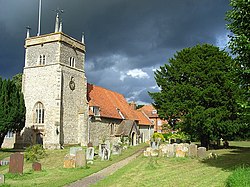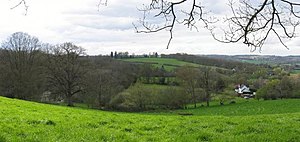Bucklebury: Difference between revisions
Created page with "{{Infobox town |name=Bucklebury |county=Berkshire |picture=St Mary's, Bucklebury - geograph.org.uk - 504227.jpg |picture caption=St Mary the Virgin parish church |os grid ref=..." |
|||
| Line 52: | Line 52: | ||
{{reflist}} | {{reflist}} | ||
*{{ | *{{Ekwall|page=69}} | ||
*{{ | *{{VCH|3|pages=291–296}} | ||
*{{ | *{{Pevsner|pages=106–107}} | ||
Latest revision as of 00:13, 23 February 2020
| Bucklebury | |
| Berkshire | |
|---|---|
 St Mary the Virgin parish church | |
| Location | |
| Grid reference: | SU5570 |
| Location: | 51°26’2"N, 1°12’25"W |
| Data | |
| Population: | 2,066 (2001) |
| Post town: | Reading |
| Postcode: | RG7 |
| Local Government | |
| Council: | West Berkshire |
| Parliamentary constituency: |
Newbury |
| Website: | The Bucklebury Wikispace |
Bucklebury is a village in Berkshire, about five miles northeast of Newbury and 2½ miles north of the A4. It has a population of 2,066.
The village and the parish


The parish of Bucklebury has three main parts. The original village is on the banks of the River Pang. Directly south of Bucklebury village, and on higher ground, is Bucklebury Common, which is 826 acres of open grazing on managed heather and woodland. At the eastern boundary of the common is Chapel Row, incorporating local landmarks such as the Blade Bone public house, a butcher's shop with the same name, a doctor's practice and a tea shop.
In recent years the village of Upper Bucklebury has become the parish's larger residential area. This is on a hill about a 1.5 miles (2.4 km) south-west of Bucklebury village at the western tip of the common. Upper Bucklebury has a general store, a public house, the new Church of England parish church, All Saints, and a Church of England primary school.
The hamlet of Marlston is also in the parish.
Name
The place-name 'Bucklebury' is first attested in the Domesday Book, as 'Borgeldeberie', which appears to reflect the Old English Burghilde burg or Burghilde beorg, meaning "Burghild's fortified place" or "Burghild's Hill".[1] Whoecver Burghild was we do not know: she has left no known trace in the record beyond her name.
History
Bucklebury was a royal manor owned by Edward the Confessor (reigned 1042–66).[2] The village and parish church are recorded in the Domesday Book of 1086.[2] Henry I (reigned 1100–35) granted Bucklebury to the Cluniac Reading Abbey, which retained it until it surrendered all its lands to the Crown in the Dissolution of the Monasteries in 1540.[2]
Bucklebury has a number of country homes and estates of interest, including Bucklebury Manor, a Georgian mansion on Pease Hill which contains within its interior an early C17 ashlar fireplace that is carved with panelled pilasters that support a rich cornice. There is also an over mantel with shallow carved decoration, and a moulded flat arch with Delft type glazed tiles behind.[3] This was the family home of Catherine, Duchess of Cambridge.
In the Second World War much of Bucklebury Common was cleared for the stationing of troops. Some of the concrete paths laid down still remain and are now used as bridleways.
Parish church
The parish church is St Mary the Virgin. It is thought to have been built in the second half of the 11th century.[2] The ornate south doorway is late Norman[4] and was added in about 1170.[2] A north transept was added to the nave at the end of the 12th or beginning of the 13th century.[2] Late in the 13th century a second arch was added to turn the transept into a two-bay north aisle.[2] One of the windows in the south wall of the nave was added in the 14th century.[2]
In the 15th century the nave and north aisle were lengthened westwards by the addition of a third bay, and new east and two new north windows were inserted in the north aisle.[2] In the second half of the 15th century the Perpendicular Gothic[5] bell tower was added.[2] The chancel was rebuilt in 1591 and the porch was added in 1603.[2] The chancel was partly rebuilt again in 1705 and the porch has also been rebuilt.[2] A vestry has also been added.[2]
The Rectory has an early 18th-century facade.[5] In 1966 the garden included two sculptures by Henry Moore: Draped Reclining Woman 1957–58 and Reclining Figure (1961–62).[5]
Outside links
| ("Wikimedia Commons" has material about Bucklebury) |
References
- ↑ Ekwall 1940, p. 69.
- ↑ 2.00 2.01 2.02 2.03 2.04 2.05 2.06 2.07 2.08 2.09 2.10 2.11 2.12 Page & Ditchfield 1923, pp. 291–296.
- ↑ Bucklebury Manor - British Listed Buildings
- ↑ Pevsner 1966, p. 106.
- ↑ 5.0 5.1 5.2 Pevsner 1966, p. 107.
- Ekwall, Eilert, The Concise Oxford Dictionary of English Place-Names. Oxford, Oxford University Press, 4th edition, 1960. p. 69 ISBN 0198691033
- A History of the County of Berkshire - Volume 3 pp 291–296: {{{2}}} (Victoria County History)
- Nikolaus Pevsner: The Buildings of England: Berkshire, 1966; 2010 Penguin Books ISBN 978-0-300-12662-4pages 106–107
